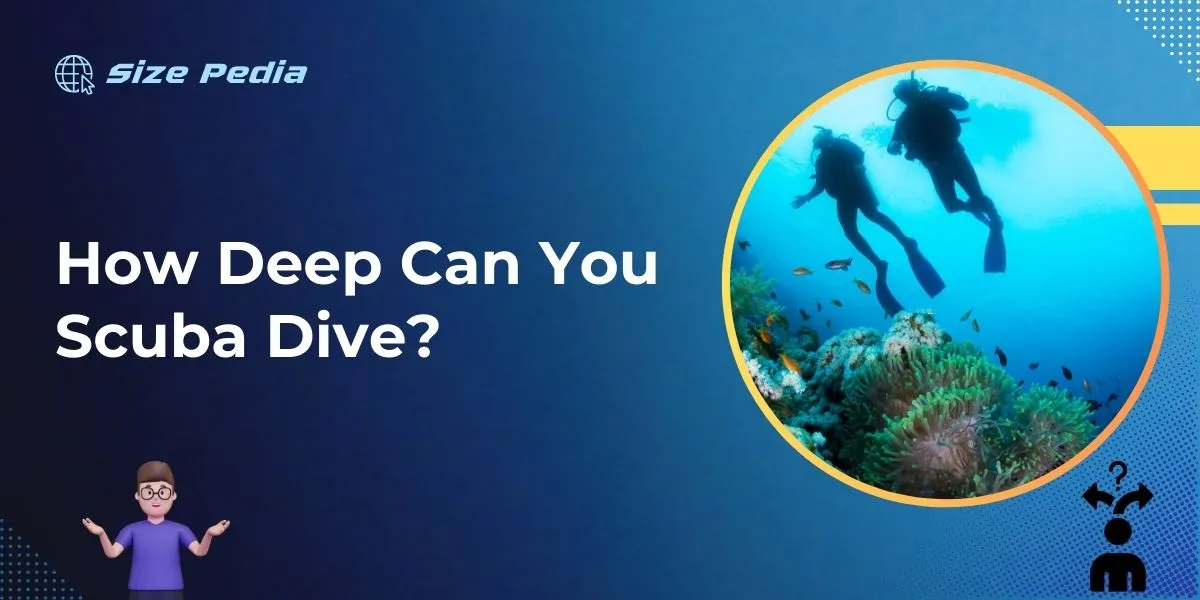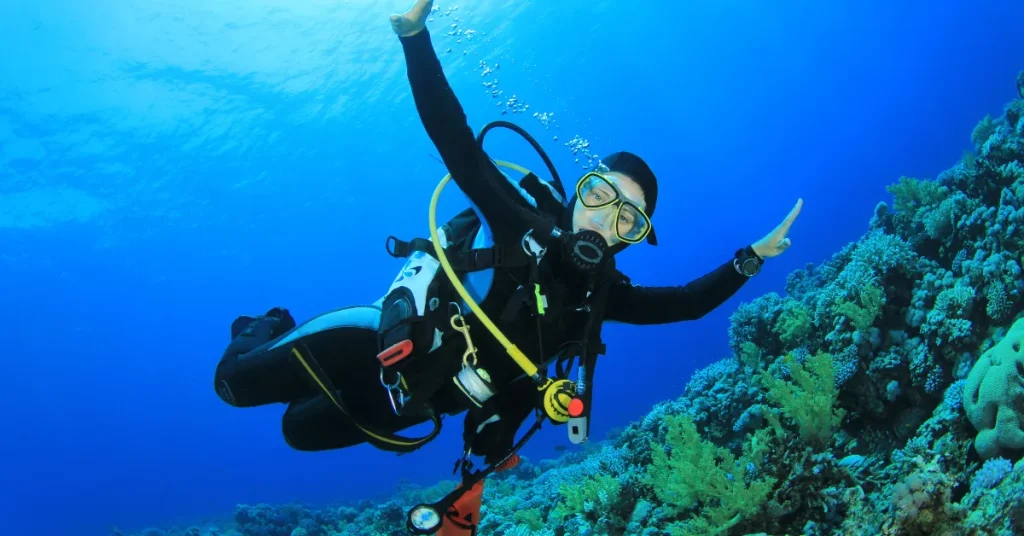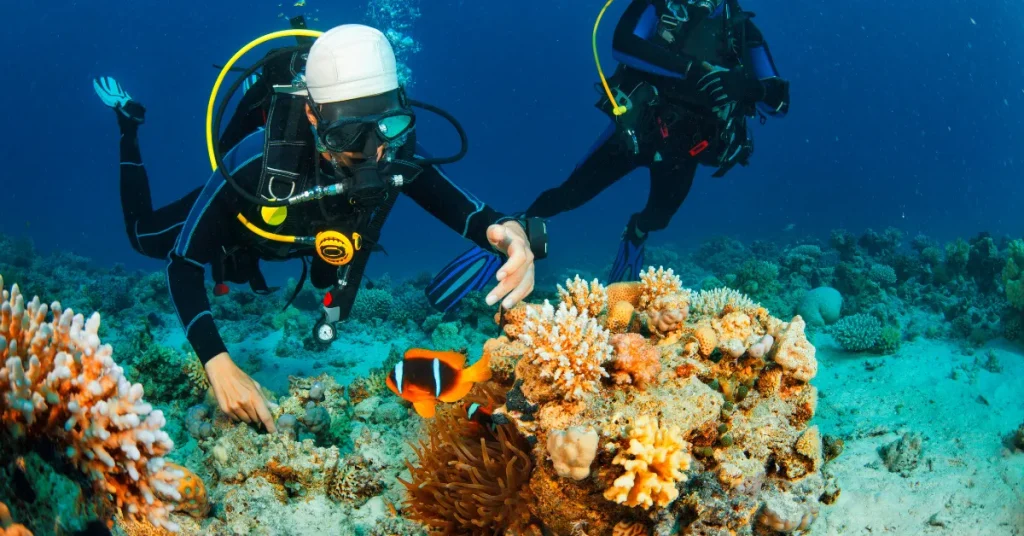Recreational scuba divers can dive up to 130 feet (40 meters) deep. The depth limit for technical divers extends beyond 130 feet.
Scuba diving is an exhilarating experience that opens up the underwater world for exploration and adventure.
Adequate training and certification are essential for safely enjoying this activity. Diving depths vary based on certification levels, experience, and the type of diving being done.
Deep dives require specialized equipment, knowledge of decompression theory, and a clear understanding of the risks involved, such as nitrogen narcosis and decompression sickness.
Divers should always dive within their limits and adhere to safety protocols to ensure a safe and enjoyable dive. With proper guidance and respect for depth limits, scuba diving can be a safe and thrilling pursuit for underwater enthusiasts.

The Lure Of The Deep Blue
The ocean calls to the daring and the curious. Its mysterious depths hold secrets from sunken ships to hidden caves. Human ambition pushes boundaries, diving deeper than ever before. An underwater world awaits, brimming with wonder and the unknown.
The Pull Of Underwater Exploration
Scuba diving is a journey into Earth’s final frontier. Every descent offers new discoveries—from vibrant coral reefs to elusive marine creatures. Divers are explorers, seeking out the marvels of the marine landscape.
- Breath-taking formations
- Rare aquatic life
- Historical wrecks
Human Fascination With Ocean Depths
The vast blue sea ignites curiosity. Humans have longed to understand the ocean’s secrets since ancient times. Ocean depths represent the ultimate challenge. The deeper the dive, the greater the allure. It’s a testament to courage and the spirit of adventure.
| Depth (feet) | What You Might Discover |
| 60-130 | Colorful reef fish, coral gardens |
| 130-250 | Shipwrecks, sharks, advanced sea creatures |
| 250+ | Uncharted territories, extreme species |
As technology evolves, so does our ability to dive deeper. Yet, beyond certain depths, divers must be highly trained.
Safety and respect for the ocean are paramount. Dives beyond the average—such as those that reach the twilight zone at 200-500 feet—require specialized gear and procedures.
Scuba Diving Basics
Welcome to the thrilling world of scuba diving! Scuba diving unlocks doors to underwater adventures. It lets you explore the depths of the ocean.
To dive safely, you need the right gear and training. It’s essential to know how deep you can dive. Each diver’s limits can vary. Dive training will define these limits for you.
Essential Gear For Divers
Every diver must have appropriate equipment. This gear keeps you safe and comfortable. Below is a list of items you’ll use:
- Mask – Your window to the underwater world
- Fins – Propels you through the water with ease
- Snorkel – Lets you breathe at the surface
- Scuba Tank – Provides air underwater
- Regulator – Controls air delivery from the tank
- Depth Gauge – Tracks your depth and time underwater
- Wetsuit – Protects and insulates your body
Remember, quality gear enhances your dive experience. Make sure everything fits well and is in good condition.
Training And Certification Processes
Proper training is vital for diving. You need to learn skills for safe diving. Here’s an overview of the steps to become certified:
- Choose a reputable training agency – Find an organization that offers scuba certification.
- Complete the coursework – Learn the theory of diving through classes or online learning.
- Pass the exam – Show that you understand dive theory.
- Undergo confined water training – Practice basic dive skills in a pool or shallow water.
- Finish open water dives – Apply your skills in an open water environment.
After these steps, you receive a dive certification. This card shows you can dive safely to certain depths. Always dive within your limits and never go beyond your training.
The Science Of Going Deep
Exploring the depths of the ocean through scuba diving is a thrilling adventure. But diving deep comes with its own set of rules. Let’s unravel the science of going deep under the sea and what every diver needs to know.
Understanding Pressure Underwater
As divers descend, the water above exerts more pressure on their bodies. This is measured in atmospheres (ATM).
At sea level, the pressure is 1 ATM, but it increases by 1 ATM with every 10 meters (33 feet) these divers go down. Divers must adapt to this pressure to avoid injury.
Add as many rows as needed
| Depth (meters) | Pressure (ATM) |
| 10 | 2 |
| 20 | 3 |
| 30 | 4 |
Nitrogen Absorption And Scuba Diving
Nitrogen absorption increases the deeper divers go. Breathing air under pressure causes more nitrogen to dissolve in the bloodstream. This isn’t a problem until divers begin to ascend, which is when decompression sickness, also known as the bends, can occur.
Understanding nitrogen absorption is essential:
- Dive within limits to manage absorption
- Follow dive tables or dive computers for safety
- Plan for decompression stops if needed
These stops allow nitrogen to gradually leave the body. Following the dive plan and respecting the science keeps divers safe while enjoying the underwater world.
Limits Of Recreational Scuba Diving

Diving deep into the blue waters is thrilling. Yet, it is vital to know how deep you can safely dive. Recreational scuba diving has set limits. These limits keep divers safe from the risks of the deep. Let’s dive into the details of these boundaries.
Standard Depth Range For Recreational Divers
When we talk about the depths divers can explore, clarity is key. The standard depth limit for recreational scuba diving is 130 feet (40 meters). This rule is not just a number. It’s a safety cap.
- Beginners: often start at 60 feet (18 meters) or less.
- Advanced Open Water: can aim for the full 130 feet.
Training and experience define what level divers can reach. The deeper you dive, the more skills you need. This is about safety and enjoyment under the waves.
Risks Beyond Recreational Depth Limits
Diving beyond 130 feet invites risks. The deeper a diver goes, the more they face these challenges:
| Risk | Details |
| Decompression Sickness | More time needed on ascent to prevent ‘the bends’. |
| Nitrogen Narcosis | Can cause confusion and poor decision-making. |
| Oxygen Toxicity | Raised risk with increased depth and oxygen levels. |
| Air Consumption | Air depletes faster; managing reserves is critical. |
It is clear that going deeper increases danger. Advanced equipment and training are essential below recreational limits. Divers must respect their limits. They must prioritize safety to enjoy the wonders of scuba diving.
The Frontier Of Technical Diving
Scuba diving transports you to a different world under the waves. Technical diving pushes this adventure even further. It reaches depths well beyond the limits of recreational scuba diving.
What Defines Technical Diving?
Technical diving is high-level scuba diving. It involves special techniques and advanced training. Tech divers explore deep wrecks and caves. They venture past the typical recreational dive limits. This kind of diving often exceeds depths of 40 meters (130 feet).
- Extended bottom times
- Decompression stops
- Mixed gas use
Special Equipment For Extended Depths
Tech dives require special gear for safety and success. Divers use items very different from those in recreational diving.
| Equipment | Uses |
| Twin Cylinders or Rebreathers | For better gas management and longer dive times. |
| Decompression Cylinders | To switch gas mixes during ascent. |
| Trimix/Heliox | Reduces the risk of nitrogen narcosis at deep depths. |
| Dive Computers | Specialized for tracking decompression times and gas mixtures. |
Trained tech divers can explore places few have seen. With the right skills and equipment, they can dive deeper, and stay under longer.
Extreme Depths: The World’s Deepest Dives
Scuba diving opens a door to the underwater world. Some push the limits of exploration. They dive into extreme depths. These are the world’s deepest dives. They are awe-inspiring. Yet, they are dangerous. Only a few have ventured beyond the abyss.
Record-breaking Dives And Divers
Ahmed Gabr holds a record. In 2014, he reached 332.35 meters. This is the deepest scuba dive. He dived in the Red Sea. His record is in the Guinness Book. This dive took almost 15 minutes. But his return to the surface? It took nearly 14 hours!
| Diver Name | Depth | Location | Year |
| Ahmed Gabr | 332.35m | Red Sea | 2014 |
| Herbert Nitsch | 214m | Spetses, Greece | 2007 |
Challenges Faced In Extreme Scuba Diving
Extreme depths bring big risks. These are unique to deep scuba diving.
- Pressure: Water is heavy. It presses hard against everything as you go down. It can harm your body.
- Decompression Sickness: Divers must surface slowly. If not, gas bubbles can form in their blood. This is very painful. It can be deadly.
- Narcosis: Too deep, and you may feel confused. Some call this “rapture of the deep”. It’s like being drunk.
- Equipment failures: Scuba gear can fail. In deep water, backups and planning are essential.
- Technical training: You must train a lot to dive deep. It takes years to learn and practice.
Safety Measures And Emergency Protocols
Scuba diving opens up the mysteries of the ocean. But deep exploration requires strict safety protocols.
Divers must understand risks like decompression illness and know emergency procedures. Careful planning and preparation make diving a safe, enjoyable experience.
Decompression Illness: Prevention And Treatment
Decompression illness (DCI) is a serious risk in deep diving. It can occur when divers ascend too quickly. To prevent DCI:
- Plan your dive with a slow, controlled ascent.
- Use a dive computer to monitor depth and time.
- Follow safety stops and decompression protocols.
For treatment, divers should begin oxygen first aid. They must seek medical help immediately, usually at a decompression chamber.
Emergency Planning For Deep Dives
Every deep dive needs an emergency plan. Key elements include:
- A primary plan and a backup option.
- Accessible emergency equipment.
- Clear communication signals for emergencies.
- An emergency contact list.
- Knowledge of the nearest medical facility.
Training in rescue techniques and CPR is essential. Every diver must know these skills.
Conservation Efforts In Deep-sea Diving

Conservation Efforts in Deep-Sea Diving are crucial for sustaining marine life. The ocean’s depths are filled with mysteries. To explore them, scuba divers must be acute of their environmental impact.
Protecting deep-sea ecosystems is a shared responsibility among divers. Let’s delve into how our underwater adventures affect marine environments and what we can do to be responsible deep-sea divers.
Impact Of Scuba Diving On Marine Environments
Scuba diving, while mesmerizing, can harm ocean health. Touching corals or disturbing sediment impacts marine ecosystems. Divers unaware of these risks can unintentionally disrupt habitats. Over time, these activities can lead to loss of biodiversity. Corals are sensitive; even minor contact can cause lasting damage.
- The presence of divers raises stress levels in fish.
- Irresponsible diving leads to coral breakage.
- Sedimentation chokes reefs, affecting marine life.
Diving in popular spots intensifies these effects. Continuous exposure to divers can deplete an area of its natural charm and vitality. Direct contact with marine creatures can spread diseases or stress them. It is vital to understand these impacts to preserve ocean health.
Promoting Responsible Deep-dive Practices
Responsible diving is key to conservation efforts. Firstly, deep-sea divers can minimize their impact by mastering buoyancy control. This prevents accidental harm to marine environments.
| Practice | Benefit |
| Good Buoyancy | Prevents reef contact. |
| Streamlined Gear | Reduces drag and damage. |
| Look, Don’t Touch | Protects sea life integrity. |
| Eco-Friendly Sunscreen | Prevents chemical pollution. |
Education plays a pivotal role. Dive operators and instructors must stress environmental protection. They can teach divers about the fragile underwater ecosystems. Divers can then make better decisions and inspire others to do the same.
- Take only pictures, leave only bubbles.
- Support conservation projects financially.
- Report sightings of marine distress.
- Join clean-up dives if possible.
By following these guidelines, divers ensure their adventures don’t leave a negative mark. Thus, the deep sea’s beauty and diversity can thrive for generations.
FAQs About How Deep Can You Scuba Dive
What Is The Maximum Scuba Diving Depth Limit?
The maximum scuba diving depth for recreational divers is typically set at 130 feet (40 meters). This limit is recommended to minimize the risks of decompression sickness and nitrogen narcosis. Advanced divers with specialized training may dive deeper.
How Does Depth Affect Scuba Diving Safety?
As depth increases, so do the risks associated with scuba diving. The pressure affects gas absorption and can lead to conditions like nitrogen narcosis and decompression sickness. Divers must follow safety protocols, such as slow ascents and safety stops, to mitigate these risks.
Can Beginners Dive In Deep Water Scuba?
Beginners are advised to avoid deep water scuba diving. They should stick to shallower depths, generally not exceeding 60 feet (18 meters), until they receive proper training and experience to handle the advanced conditions of deeper dives safely.
What Special Equipment Is Needed For Deep Diving?
Deep diving requires specialized equipment such as technical diving rigs, redundant gas supply systems, dive computers, and sometimes mixed gases like trimix. These systems help manage the increased risks and technical challenges of deep underwater exploration.
Conclusion
Embarking on a scuba diving adventure unlocks a spectacular underwater universe. Safety and training guide the depths you can explore, usually up to 40 meters for recreational divers.
Always remember, advancing your skills and respecting limits are crucial for a safe, mesmerizing dive experience.
Dive deep, but dive smart.
